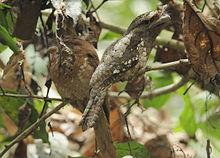- Sri Lanka Frogmouth
-
Sri Lanka Frogmouth 
A pair (female on right) of frogmouths (B. m. roonwali) at day roost Conservation status Scientific classification Kingdom: Animalia Phylum: Chordata Class: Aves Order: Caprimulgiformes Family: Podargidae Genus: Batrachostomus Species: B. moniliger Binomial name Batrachostomus moniliger
Blyth, 1849The Sri Lanka Frogmouth or Ceylon Frogmouth (Batrachostomus moniliger) is a small frogmouth found in the Western Ghats of south India and Sri Lanka. Related to the nightjars, they are nocturnal and are found in forest habitats. The sexes differ in plumage.
Contents
Description
Like all frogmouths, this 23 centimetres (9.1 in) long species has a wide and hooked bill with slit-like nostrils and the large head has the eyes facing forward to provide binocular vision. Within the genus it has a somewhat small wing and is distinguished by the wing coverts ending in veltety black spots tipped in white.[2] The male is grey brown with fine barring and a spotted crown. Some males are browner and look more similar to females. The female is more rufous or chestnut brown. Indian specimens have black spots on the crown but Sri Lankan populations have no such markings.[3] Formerly considered monotypic, the Western Ghats population have been named as B. m. roonwali. This population has the males with a brownish-gray wing mirror and yellowish spots on the underside (gray or white in the nominate Sri Lankan form). Females have a bright reddish-brown wing mirror and are unspotted below.[4][5]
Habitat and distribution
This species is found in the Western Ghats of southwest India and Sri Lanka. Its habitat is dense tropical forest usually with dense undergrowth[6] but sometimes found in more disturbed habitats including plantations.[7] Their presence can be overlooked due to their nocturnal behaviour and camouflage.[8]
Behaviour
Frogmouths are rarely seen during the day except at roost sites or when flushed. They regularly use the same roost spots for months.[9] When alarmed at their perch, they slowly move the head to point up their bill and can easily be mistaken for a jagged broken branch. They rely on their crypsis and will often allow close approach before flushing[10] or will sometimes open their mouth wide in a threatening display.[9] They are sometimes mobbed at their day roost by small songbirds.[3] They are vocal at dusk, the call of the female being a loud screechy "shkeerauuw" which drops in loudness and ends is a series of hiccups. Another call is a series of rapid "skwar-skwar-skwar" which is produced by both males and females.[3] The breeding season in southern India is January to April and February to March in Sri Lanka. The nest is a small pad made of moss lined with down and covered on the outside with lichen and bark. A single white egg is laid and the incubating bird covers it entirely and holds the tail flush with the tree to avoid breaking the outline and appears like a lichen covered snag. The male appears to incubate during the day.[10][11] After the chick leaves the nest, a male bird removed the nest and the same branch may be used each year to build a new nest.[12] The young bird may stay with the parents for a couple of months, huddling between the parents at the roost.[9]
References
- ^ BirdLife International (2009). "Batrachostomus moniliger". IUCN Red List of Threatened Species. Version 2011.1. International Union for Conservation of Nature. http://www.iucnredlist.org/apps/redlist/details/143337. Retrieved 26 July 2011.
- ^ Marshall, JT (1978). Systematics of smaller Asian night birds based on voice. Ornithological Monographs 25. American Ornithologists' Union. p. 28. http://elibrary.unm.edu/sora/om/om025.pdf.
- ^ a b c Rasmussen PC & JC Anderton (2005). Birds of South Asia. The Ripley Guide. Volume 2. Washington DC & Barcelona: Smithsonian Institution and Lynx Edicions. pp. 249–250.
- ^ Dutta BB (2009). "Studies of the Ceylone [sic] Frogmouth, Batrachostomus moniliger Blyth from India, with the description of a new sub-species from Western Ghats". Rec. Zool. Survey India 109 (2): 79–85.
- ^ Martens J & Bahr N (2011). "Documentation of new bird taxa, 5. Report for 2009". Vogelwarte 49: 85–104. http://www.do-g.de/fileadmin/do-g_dokumente/Vogelwarte_2-2011.pdf.
- ^ Sugathan, R (1981). "A survey of the Ceylon Frogmouth (Batrachostomus moniliger) habitat in the Western Ghats of India". J. Bombay Nat. Hist. Soc. 78 (2): 309–316.
- ^ Borges, Renee (1986). "On the occurrence of the Ceylon frogmouth (Batrachostomus moniliger) in north Kanara, Karnataka". Journal of the Bombay Natural History Society 83 (1): 200.
- ^ Kumara, H.N. Singh, M. (2006). "Ceylon Frogmouth Batrachostomus moniliger Blyth in the rainforests of the Western Ghats, Karnataka". J. Bombay Nat. Hist. Soc. 103 (1): 100.
- ^ a b c Kannan, R (1994). "Notes on the status and ecology of the Ceylon Frogmouth (Batrachostomus moniliger Blyth) from the Anaimalai Hills of Tamil Nadu". J. Bombay Nat. Hist. Soc. 91 (3): 454–455.
- ^ a b Phillips, W. W. A. (1947). "A Note on the Nesting of the Ceylon Frogmouth, Batrachostomus moniliger Blyth". Ibis 89 (3): 515–516. doi:10.1111/j.1474-919X.1947.tb04373.x.
- ^ Ali, S & S D Ripley (1983). Handbook of the Birds of India and Pakistan. Volume 4 (2 ed.). New Delhi: Oxford University Press. pp. 1–3.
- ^ Jayarathna, K D Thandula (2004). "Observations on a nest of Sri Lanka Frogmouth Batrachostomus moniliger". Forktail 20: 129–130. http://www.orientalbirdclub.org/publications/forktail/20pdfs/Jayarathna-Frogmouth.pdf.
External links
Categories:- IUCN Red List least concern species
- Batrachostomus
- Birds of India
- Birds of Sri Lanka
Wikimedia Foundation. 2010.


